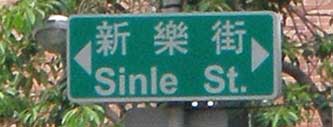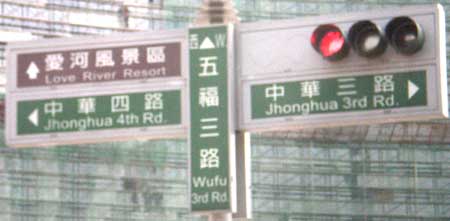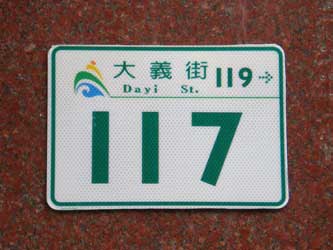Years of valuable time has been lost in the squabbling over romanization systems for Taiwanese. And that squabbling will no doubt continue, as the links below make clear. But an important step was taken on Thursday. Finally, finally, Taiwan’s Ministry of Education has approved a romanization system for Taiwanese: Tái-luó-bǎn Pīnyīn (台羅版拼音), to give its Mandarin name.
I’m already on the record as having called Tongyong Pinyin, in its various incarnations, a national embarrassment for Taiwan, so I won’t bother to disguise the fact that I got a real kick out of the fact that the Tongyong Pinyin scheme for the Taiwanese language was roundly rejected. I know that more than a few readers of Pinyin News will be cheering this news. For many, this has as much or more to do with the methods used to push through the much-despised Tongyong Pinyin system for Mandarin than any defects, real or imagined, in the Tongyong Pinyin system for Taiwanese.
Predictably, Yu Bo-quan (余伯泉, I’ve given up bothering to figure out which of the various spellings for his name he’s using now), the main person behind the Tongyong romanization systems, is unhappy. Reportedly, after it was clear things were not going his way he stormed out of the meeting. After he left the new system was approved unanimously.
Yu’s remarks make clear the political nature of his approach.
Tái-luó-bǎn pīnyīn xìtǒng zuó chuǎngguān chénggōng hòu, Yú Bó-quán qìfèn de shuō, Tái-luó xìtǒng de qǐyuán shì Táiwān Mǐnnányǔ yīnbiāo xìtǒng (TLPA), shì Guómíndǎng shídài de chǎnwù, ér 2002 Tōngyòng Pīnyīn shì Mínjìndǎng zhízhèng nèi tōngguò de, zhìyí wèihé Jiàoyùbù wúfǎ hànwèi zhízhèngdǎng de Mǐnnányǔ pīnyīn xìtǒng zhǔzhāng, Jiàoyùbù duànrán tōngguò Tái-luó-bǎn, Táiwānyǔ Tōngyòng Liánméng hòuxù jiāng zhǔnbèi kàngzhēng. (台羅版拼音系統昨闖關成功後,余伯泉氣憤地說,台羅系統的起源是台灣閩南語音標系統(TLPA),是國民黨時代的產物,而二○○二通用拼音是民進黨執政內通過的,質疑為何教育部無法捍衛執政黨的閩南語拼音系統主張,教育部斷然通過台羅版,台灣語通用聯盟後續將準備抗爭。)
That doesn’t sound all that far from calling those on the committee dupes of the KMT, which isn’t likely to win him any friends with those in power. But it may well be that by this point he has so alienated others he thinks he has nothing to lose.
Apparently Tongyong for Taiwanese will retain something of a foothold in southern Taiwan. (See source no. 8 below.)
Later, I’ll try to put up more about just what system was approved and under what circumstances it will (and will not) be used — unless the ever-knowledgeable a-giâu beats me to it.
Because there’s a lot of confusion about Tongyong, a few notes are in order:
- Tongyong is not one romanization system for all the languages of Taiwan but rather a group of related systems, some of which could be said to work better (or worse) than others.
- When Tongyong (for Mandarin) was officially approved in Taiwan in 2002, the Tongyong system for Hakka also received approval but not the Tongyong Pinyin system for Taiwanese.
- As the vote should make clear, plenty of strong supporters of romanization (and other scripts) for Taiwanese have never much cared for Tongyong.
sources:
- Tái-luó-bǎn pīnyīn míngnián shànglù; Jiàoyùbù duànrán dìng’àn; Tōngyòng liánméng jiāng kàngzhēng (台羅版拼音明年上路 教育部斷然定案 通用聯盟將抗爭), Píngguǒ Rìbào (Apple Daily), September 29, 2006
- Guóxiǎo lǎoshī: xiāngtǔ yǔyán zuìhǎo zìrán xuéxí (國小老師:鄉土語言最好自然學習), Liánhé Xīnwén Wǎng, September 29, 2006
- Zuóyè zuìxīn: Mǐnnányǔ xiāngtǔ jiàoxué quèdìng cǎi Táiwān Mǐnnányǔ Luómǎzì pīnyīn (昨夜最新:閩南語鄉土教學確定採台灣閩南語羅馬字拼音), CNA, September 29, 2006
- Táiyǔ Tōngyòng liánméng kàngyì Jiàoyùbù cǎi Mǐnnányǔ Luómǎ pīnyīn (台語通用聯盟抗議教育部採閩南語羅馬拼音), CNA, September 29, 2006
- Mǐnnányǔ xiāngtǔ jiàoxué quèdìng cǎi Táiwān Mǐnnányǔ Luómǎzì pīnyīn (閩南語鄉土教學確定採台灣閩南語羅馬字拼音), CNA, September 29, 2006
- Mǐnnányǔ pīnyīnfǎ quèlì: Luómǎ pīnyīn shèng chū (閩南語拼音法確立:羅馬拼音勝出), Zhōngguǎng Xīnwén Wǎng, September 29, 2006
- Pāibǎn dìng’àn! Jiàoyùbù tōngguò Mǐnnányǔ jiàoxué; cǎiyòng Tái-luó pīnyīn (拍板定案!教育部通過閩南語教學 採用台羅拼音), Dōngsēn Xīnwénbào, September 29, 2006
- Nánbù sì xiàn-shì dǐzhì; Tái-luó pīnyīn jīn chuǎngguān (南部四縣市抵制 台羅拼音今闖關), Zhōngshí Diànzǐ Bào, September 29, 2006

 During an extremely brief trip a few weeks ago to
During an extremely brief trip a few weeks ago to 




